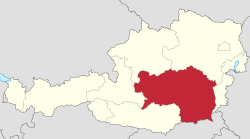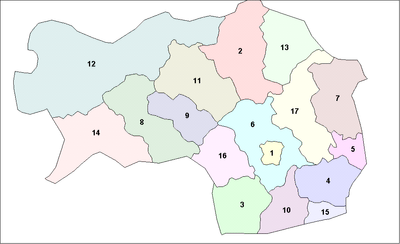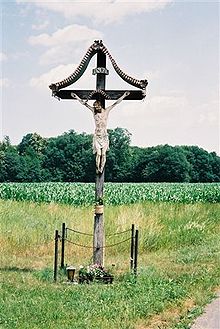- Styria
-
Styria
Steiermark— State of Austria — 
Flag
Coat of armsCountry  Austria
AustriaCapital Graz Government – Governor Franz Voves (SPÖ) Area – Total 16,401.04 km2 (6,332.5 sq mi) Population – Total 1,210,700 – Density 73.8/km2 (191.2/sq mi) Time zone CET (UTC+1) – Summer (DST) CEST (UTC+2) ISO 3166 code AT-6 NUTS Region AT2 Votes in Bundesrat 9 (of 62) Website www.verwaltung.steiermark.at Styria (German: Steiermark, pronounced [ˈʃtaɪ.ɐmaʁk], Slovene: Štajerska) is a state or Bundesland, located in the southeast of Austria. In area it is the second largest of the nine Austrian federated states, covering 16,401 km². It borders Slovenia as well as the other Austrian states of Upper Austria, Lower Austria, Salzburg, Burgenland, and Carinthia. The population (as of 2011) was 1,210,700. The capital city is Graz (255,000 inhabitants).
Contents
Geography
The term "Upper Styria" (German: Obersteiermark) used by an Austrian refers to the northern and northwestern parts of the federal-state (districts Liezen, Murau, Judenburg, Knittelfeld, Leoben, Bruck an der Mur, and Mürzzuschlag). The term "West Styria" (Weststeiermark) is used for the districts to the west of Graz (Voitsberg, Deutschlandsberg, western part of the district Leibnitz), the districts east of Graz (Weiz, Hartberg, Feldbach, Fürstenfeld, and Radkersburg) are referred to as "East Styria" (Oststeiermark). The western and eastern parts of the district Graz-Umgebung may or may not be considered parts of West and East Styria, respectively. The southern parts of the Duchy of Styria, which have formed part of Slovenia since 1918, were (and sometimes colloquially still are) referred to as "Lower Styria" (Untersteiermark; Slovene: Štajerska).
History
During early Roman times, Styria was inhabited by Celtic tribes. After its conquest by the Romans, the eastern part of what is now Styria was part of Pannonia, while the western one was included in Noricum. During the Barbarian invasions, it was conquered or crossed by the Visigoths, the Huns, the Ostrogoths, the Rugii, the Lombards, the Franks and the Avars. In 595 the latter were defeated by the Slavs, who thenceforth ruled it.
In 1180 Styria separated from the Duchy of Carinthia and became a Grand Duchy of its own; in 1192 it became part of Austria. After the hereditary subdivision of the latter, Styria formed the central part of Inner Austria.
Styria developed culturally and economically under Archduke John from 1809 and 1859. In 1918, after World War I, it was divided into a northern section (forming what is the current Austrian state), and a southern one, called Lower Styria, inhabited mostly by ethnic Slovenians, and which was annexed to Yugoslavia, and later in Slovenia.
Economy
As elsewhere in the developed world, there has been a shift away from the manufacturing sector towards the service sector in Styria. This has had negative consequences for the industrial regions of upper Styria which have suffered a steady decline in population in recent years. In 2004 Styria had the strongest economic growth rate in Austria at 3.8% - mainly due to the Graz area which saw strong economic growth that year and has continued to grow in economic and population terms since then.
Styria is home to more than 150 cleantech companies, of which one dozen are world technology leaders in their field. The cleantech revenue of Styrian companies totals €2.7 billion. This equals to 8 percent of the Gross Regional Product (GRP), and is one of the highest concentrations of leading clean technology companies in Europe. The companies have an average (real) growth rate of 22 percent per year—well above the worldwide cleantech market growth of 18 percent per year. The region created roughly 2,000 additional green jobs in 2008 alone. [1]
Administrative divisions
The state is divided into 16 districts (Bezirke), and a statutory city.
Statutory City
Districts
- Bruck an der Mur
- Deutschlandsberg
- Feldbach
- Fürstenfeld
- Graz-Umgebung
- Hartberg
- Judenburg
- Knittelfeld
- Leibnitz
- Leoben
- Liezen with the subdistricts
Gröbming and Bad Aussee - Mürzzuschlag
- Murau
- Radkersburg
- Voitsberg
- Weiz
Politics
The state had been a stronghold of the Austrian People's Party (ÖVP) since 1945. Graz however is a stronghold for the left-wing Communist Party (KPÖ). The governor (Austrian political term: Landeshauptmann) was usually a member of the ÖVP.
2005 Elections
In the latest elections for state parliament the Social Democrats (SPÖ) under their regional chairman Franz Voves won the majority after the ÖVP had damaged its credibility through scandals and the secession of a high-ranking party member who took part in the 2005 election after setting up his own party. In this election, the Communist Party (KPÖ) also received many votes after it had gained much popularity through its role in local politics in Graz during the preceding few years. The two right wing populist parties, the FPÖ and the BZÖ both failed to win seats.
Notable persons
- Peter Rosegger (born 1843), poet
- Elfriede Jelinek (born 1946), Nobel Prize in Literature winner
- Jochen Rindt (1942–1970), Formula 1 World Champion
- Dr. Helmut Marko (born 1943), former racing driver
- Dietrich Mateschitz (born 1944), founder and CEO of Red Bull, billionaire
- Klaus Maria Brandauer (born 1944), actor and director
- Frank Stronach (born 1932), founder of Magna International, billionaire
- Arnold Schwarzenegger (born 1947), Hollywood actor and former Governor of California
- Thomas Muster (born 1967), former World No. 1 tennis player
- Renate Götschl (born 1975), alpine skiing World Champion
- Elisabeth Görgl (born 1981), professional alpine skier
- Ulla Weigerstorfer (born 1967), Miss Austria and Miss World 1987
- Andreas Münzer (born 1966, died 1996), professional bodybuilder.
- Johann Puch, (slovene: Janez Puh, b. 1862 in Juršinci, Slovenia, died 1914), founded Johann Puch Erste Steiermärkische Fahrrad-Fabriks-Aktiengesellschaft at Graz in 1899.
- Johann Joseph Fux (born 1660 - died 1741), composer and music theorist, wrote Gradus ad Parnassum - a composition manual used by many famous composers including Beethoven and Mozart.
See also
References
- ^ Lesser, Shawn. "Top 10 cleantech cluster organizations for 2010". Clean Tech Group. http://cleantech.com/news/5640/top-10-cleantech-clusters. Retrieved 14 April 2011.
External links
- Imperial Austria: Treasures of Art, Arms and Armor from the State of Styria - The Canadian Museum of Civilization
- Official Tourism Website of Styria
States of Austria  Burgenland ·
Burgenland ·  Carinthia ·
Carinthia ·  Lower Austria ·
Lower Austria ·  Salzburg ·
Salzburg ·  Styria ·
Styria ·  Tyrol ·
Tyrol ·  Upper Austria ·
Upper Austria ·  Vienna ·
Vienna ·  Vorarlberg
Vorarlberg Cities and districts (Bezirke) of Styria
Cities and districts (Bezirke) of StyriaCities 
Districts Bruck an der Mur • Deutschlandsberg • Feldbach • Fürstenfeld • Graz-Umgebung • Hartberg • Judenburg • Knittelfeld • Leibnitz • Leoben • Liezen • Mürzzuschlag • Murau • Radkersburg • Voitsberg • WeizCategories:- States of Austria
- Styria
- Divided regions
- NUTS 2 statistical regions of the European Union
- Wine regions of Austria
Wikimedia Foundation. 2010.



